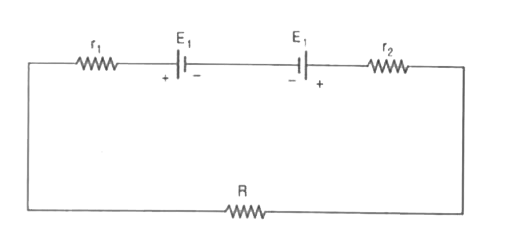Two cells of emf and are joined in opposition (such that ). If and be the internal resistances and R be the external resistance, then the terminal potential difference is :

The correct Answer is:B
V=IR
Topper's Solved these Questions
- CURRENT ELECTRICITYBook:MODERN PUBLICATIONChapter:CURRENT ELECTRICITYExercise:MULTIPLE CHOICE QUESTIONS (LEVEL-III)
Explore 13 Videos
- ATOMS, MOLECULES AND NUCLEIBook:MODERN PUBLICATIONChapter:ATOMS, MOLECULES AND NUCLEIExercise:Recent Competitive Questions
Explore 40 Videos
- DESCRIPTION OF MOTION IN ONE DIMENSION Book:MODERN PUBLICATIONChapter:DESCRIPTION OF MOTION IN ONE DIMENSION Exercise:Revision Test
Explore 45 Videos
Similar Questions
Two cells of emf E1 and E2 are joined in opposition (such that E1>E2) . If r1 be the internal resistances and R be the external resistance, then the terminal potential difference is

View SolutionIf E is the emf of a cell of internal resistance r and external resistance R, then potential difference across R is given as
View Solution
Knowledge Check
If E is the emf of a cell of internal resistance r and external resistance R, then potential difference across R is given as
AV=E/(R+r)BV=ECV=E/(1+r/R)DV=E/(1+R/r)A cell of e.mf. E and internal resistance r is connected in series with an external resistance nr. Then, the ratio of the terminal potential difference to E.M.F.is
A(1n)B1(n+1)Cn(n+1)D(n+1)nA cell of e.mf. E and internal resistance r is connected in series with an external resistance nr. Then, the ratio of the terminal potential difference to E.M.F.is
A1/nB1n+1Cnn=1Dn+1n
A cell of e.mf. E and internal resistance r is connected in series with an external resistance nr. Then, the ratio of the terminal potential difference to E.M.F.is
View SolutionA cell of emf E and internal resistance r is connected in series with an external resistance nr. Than what will be the ratio of the terminal potential difference to emf, if n=9.
View SolutionA cell of emf E and internal resistance r is connected in series with an external resistance nr. Than what will be the ratio of the terminal potential difference to emf, if n=9.
View SolutionA cell of emf (E) and internal resistance r is connected across a variable external resistance . R. The graph of terminal potential difference V as a function of R is
View SolutionA cell of e.m.f (E) and internal resistance (r) is connected in series with an external resistance (nr.) then the ratio of the terminal p.d. to E.M.F is
View Solution
